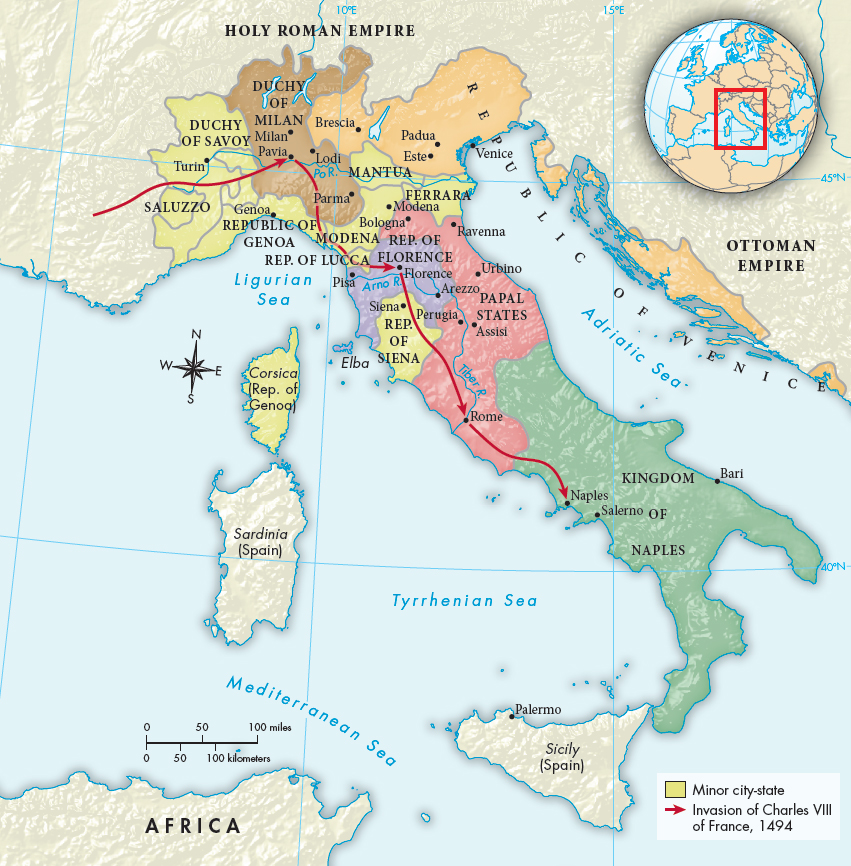City-States and the Balance of Power
Renaissance Italians had a passionate attachment to their individual city-states. Their political loyalty and feeling centered on the city. This intensity of local feeling perpetuated the dozens of small states and hindered the development of one unified Italian state.
In the fifteenth century, five powers dominated the Italian peninsula: Venice, Milan, Florence, the Papal States, and the kingdom of Naples (Map 12.1). The major Italian powers controlled the smaller city-states and competed furiously among themselves for territory. While the states of northern Europe were moving toward centralization and consolidation, the world of Italian politics resembled a jungle where the powerful dominated the weak.

MAP 12.1
The Italian City-States, ca. 1494In the fifteenth century, the Italian city-states represented great wealth and cultural sophistication, though the many political divisions throughout the peninsula invited foreign intervention.
In one significant respect, however, the Italian city-states anticipated future relations among competing European states after 1500. Whenever one Italian state appeared to gain a predominant position within the peninsula, other states combined against it to establish a balance of power. In the formation of these alliances, Renaissance Italians invented the machinery of modern diplomacy: permanent embassies with resident ambassadors in capitals where political relations and commercial ties needed continual monitoring.
At the end of the fifteenth century, Venice, Florence, Milan, and the papacy possessed great wealth and represented high cultural achievement. Wealthy and divided, however, they were also an inviting target for invasion. When Florence and Naples entered into an agreement to acquire Milanese territories, Milan called on France for support, and the French king Charles VIII (r. 1483–1498) invaded Italy in 1494.
Prior to this invasion, the Dominican friar Girolamo Savonarola (1452–1498) had preached in Florence a number of fiery sermons, attended by large crowds, predicting that God would punish Italy for its moral vice and corrupt leadership. Florentines interpreted the French invasion as the fulfillment of this prophecy and expelled the Medici, the powerful banking family that had ruled Florence since 1434. Savonarola became the political and religious leader of a new Florentine republic and promised Florentines even greater glory in the future if they would reform their ways. For a time, Savonarola was wildly popular, but eventually people tired of his moral denunciations. He was excommunicated by the pope, tortured, and burned at the stake, and the Medici returned as the rulers of Florence.
The French invasion inaugurated a new period in Italian and European power politics. Italy became the focus of international ambitions and the battleground of foreign armies, particularly those of the Holy Roman Empire and France in a series of conflicts called the Habsburg-Valois wars. The Italian cities suffered severely from continual warfare, especially in the frightful sack of Rome in 1527 by imperial forces under the emperor Charles V. Thus, the failure of the city-states to consolidate, or at least to establish a common foreign policy, led to centuries of subjection by outside invaders. Italy was not to achieve unification until 1870.
Why and how did Florence emerge as a key center of the Renaissance in the fifteenth century?
